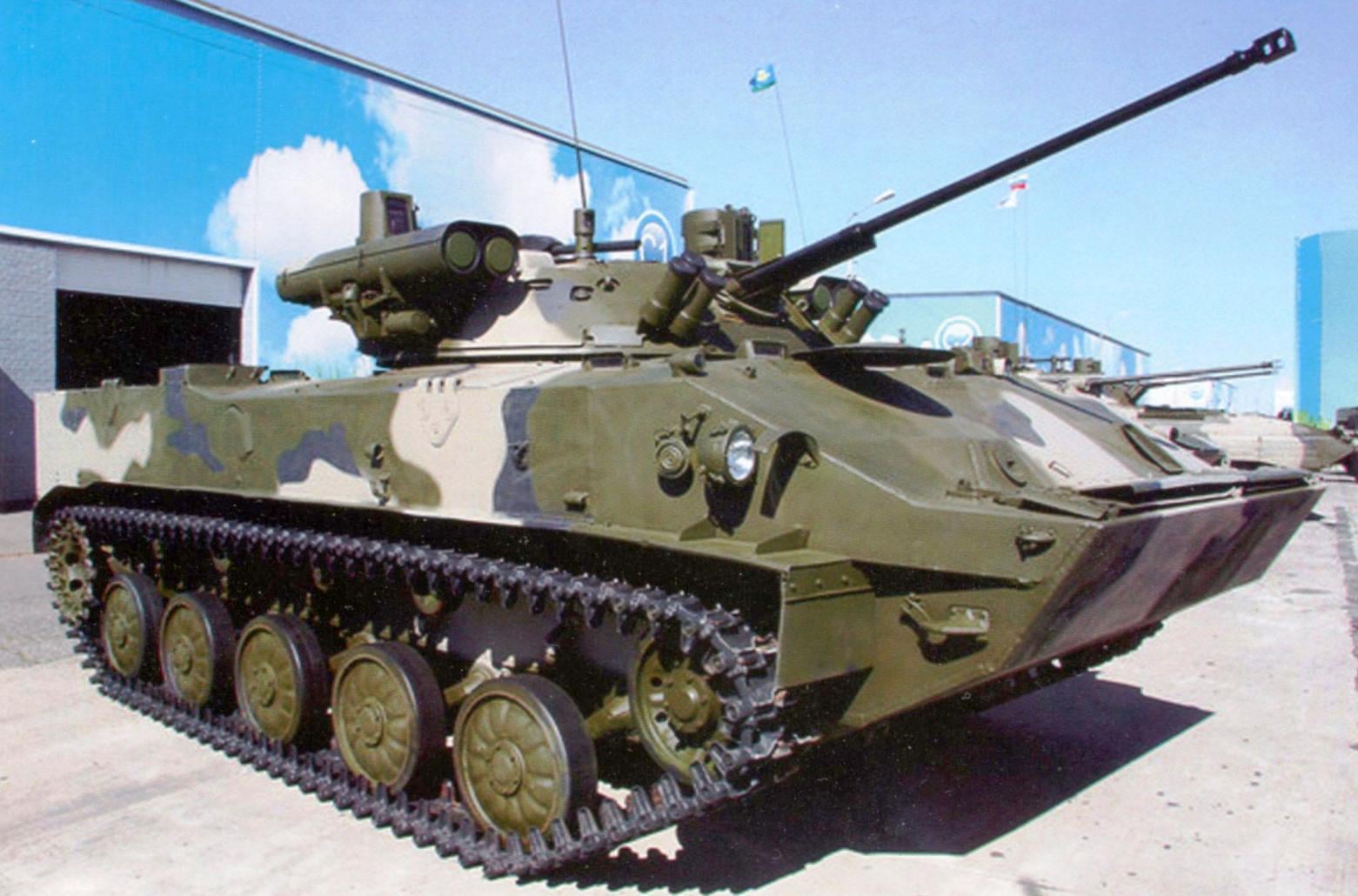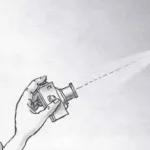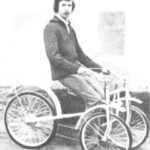 Military paratroopers wearing the blue beret. If combat vehicles and airborne troops also “gave” blue berets, they first would have to own a BMD (airborne combat vehicle). The revision in the mid-1960s, the concepts of military doctrine identified the need for a reorganization of the airborne troops of Russia (VDV). To combat landing needed new equipment, a significant increase in its firepower. Division needed armored vehicles that could carry out not only the transportation of troops, conducting the fight “under armor”, but the fight against enemy armored vehicles, with its manpower in the distance.
Military paratroopers wearing the blue beret. If combat vehicles and airborne troops also “gave” blue berets, they first would have to own a BMD (airborne combat vehicle). The revision in the mid-1960s, the concepts of military doctrine identified the need for a reorganization of the airborne troops of Russia (VDV). To combat landing needed new equipment, a significant increase in its firepower. Division needed armored vehicles that could carry out not only the transportation of troops, conducting the fight “under armor”, but the fight against enemy armored vehicles, with its manpower in the distance.
Used in the amphibious army vehicles GAZ-66, GAZ-69 – for transporting a self-propelled gun SD-44, the 122-mm howitzer D-30 – to support the infantry, self-propelled antitank missile systems (ATGM) on the basis of the reconnaissance vehicles (BRDM), and artillery self-propelled ASU-57 and CA-85 – to fight with armor did not correspond sufficiently to the new demands of doing the rolling of the battle.
With the development of the fighting vehicles of a landing was made by commander of the airborne troops Colonel-General V. Margelov. It was assumed the production of the armored tracked amphibious model which could be transported by air, quickly unloaded from aircraft or dropped by parachute.
The first such combat troops took service with the Soviet Army in 1969 under the designation BMD-1. It “was intended to transport personnel, increasing their mobility, armament and protection on the battlefield and support them with fire and gun”.
BMD “provided by our airborne troops unprecedented power and flexibility.” This unique technique not possessed no army in the world. Airborne troops from light infantry became mechanized and airmobile troops.
First, these machines were shown to foreign representatives on maneuvers “Dvina” of the armies of the Warsaw Treaty in 1970.
BMD-1 began to produce at the Volgograd tractor plant commercially since 1968, even before the adoption of the army service. They had a welded body of high strength aluminum alloy, first used in our machinery in order to protect the crew from small arms fire and shell splinters.

BMD-3 with uploaded by means of air dropping parachute strapdown system PBS-950

BMD-3. Weight of the machine is 13 tons, engine power – 450 HP and is armed with 30-mm gun 2A42, PKT machine guns and RPKS, grenade launcher, anti-tank systems

Tower BMD-3:
1 – grenade 902В; 2 – sight 1ПЗ-3; 3 – illuminator OU-ZGA-2; 4 – sight BPK-2-42; 5 – illuminator AW-3

Feed machine with the cover removed. In the center mechanism of a hydrostatic transmission, on the sides of the impellers water cannons
Mounted on it the tower was completely identical standing on the infantry fighting vehicle BMP-1; the main part was cast. Tower single, it was the gunner, who was firing from smooth-bore semi-automatic 73-2А48 mm cannon and coaxial 7.62-mm PKT machine-gun; the gun was equipped with a loading mechanism. Armament was not stable.
On the roof of the tower mounted launcher anti-tank guided missiles 9М14М (ATGM). Two bow, 7.62-mm machine gun was mounted in the front of the case. Of them fired the commander and the gunner, who held seats in the front of the machine. Just beyond the tower in case there were places for three Marines.
Engine – diesel 5Д20 capacity of 240 HP was located in the aft.
Design of hydrodynamic suspension gave the ability to change the machine clearance in the range of 100 – 450 mm. For movement afloat used a water-jet propulsion.
BMD-1, with a mass of 7.6 tonnes, could be transported by air aircraft an-12, An-22. The landing of them were made on the airfields or specially prepared terrain. However, in the early 1970s, to reset the machines from the aircraft directly in the flight began to use multi-dome parachute system ISS-5-128M and ISS-5-128Р with three or five parachutes with a dome area is 760 m2 each.

BMD-3:
1 – 30-mm 2A42 gun; 2 – conical tower; 3 – launcher ATGM 9М111; 4 – whip antenna; 5 – driving wheel; 6 – output gear; 7 – balneotreatment flap; 8 – hatch gunner; 9-sight 1ПЗ-3; 10 – hatch commander’s; 11 – Luke gunner; 12-surveillance device TNPT-1; 13 – surveillance device TEEP 170A; 14 – coaxial machine gun PTK; 15 – hatch of a bomber; 16 – driver’s hatch; 17 – Cabinet gun RPKS-74; 18 illuminator OU-5; 19 – illuminator OU-ЗГА2; 20 – sight BPK-2-42; 21 – 902В smoke grenade launchers “Tucha”; 22 – corpus grenade launcher AGS-17; 23 – valve jet
The systems included: exhaust parachute system (UPU, weighing about 50 kg) to retrieve military equipment from the failure plane; optional discharge chute (MDF) for a quick introduction of the main parachutes, four or five blocks (depending on the mass of the platform with the load) of the main parachutes.
Optional discharge chute and blocks the main parachutes were placed directly on the machine. The tower was her sacensas to prevent accidental engagement of the parachute during opening, or a touch over exposed parts of the towers and weapons.
Was also mastered parachute platform P-7, representing a “metal construction removable wheels”, which is attached to drop pod technique. The mass of the platform was 1.5 — 2.0 t, it could strengthen loads of 3.5 to 9.5 T. the Reset was done with Il-76 or An-12 and An-22 at speeds of 260 – 400 km/h For the repayment of hitting the ground or applied air cell shock absorbers.
The An-12 could carry one BMD, the An-22 four. However, the crew jumped separately from them, which in many cases led to their wide variation, and it questioned the timely fulfillment of combat tasks.
In 1973, he developed a complex “kentavar”, which could be reset equipment directly with the crew in the body of a machine. More perfect was the parachute-rocket system prsm-915 – “strapdown airborne vehicle designed for landing specially prepared cargo and combat vehicles from Il-76 and An-22, equipped with a roller conveyer, or from aircraft An-12B with conveyors TG-12M”. This system allowed the use of only one main parachute with an area of 540 m2 and the use of a powder jet engine-brake, which was extinguished by the landing speed 25 m/s to zero.
CHARACTERISTICS OF THE SHELLS 2A42

THE PENETRATION OF THE 2A42 CANNON SHELLS*

THE PERFORMANCE CHARACTERISTICS OF COMBAT VEHICLES

In 1985, the Navy had adopted a modernized version of the combat vehicle BMD-2. Changes have affected, in particular, the suspension of the filtration installation. But the main attention was paid to strengthening the arms. On the car put a new tower with an automatic 30-mm cannon 2A42, but was reduced to two the number of 7.62-mm machine gun. The tower had a circular rotating and vertically gun could elevate the barrel to 75°. Set two-plane stabilizer arms 9Э36-3. For guidance and aiming now used combo sight BPK-2-42, anti-aircraft sight PZU-8, periscope devices, TNPO-170A. BMD supplied ATRA 9М111 with two missiles 9М111М “faggot” and one 9М113 “Competition”, placing the launcher 9П135М on the roof of the tower; mounted infrared light source OU-5.
Like its predecessor, BMD-2 could be transported by air in the cargo compartments of airplanes and parachute with parachute system ISS-5 or prsm-915.
Fighting vehicle BMD-3 was accepted into service of the airborne troops in 1990 found that “the further development of BMD-2 by upgrading was not possible – all the reserves of construction have been exhausted”. Then in the design Bureau of Volgograd tractor plant developed a new airborne machine, with a unified fighting machine of infantry BMP-2 double tower. It housed a 30 mm cannon 2A42 and coaxial 7.62-mm machine gun PKT, as well as the jobs of commander (starboard side) and gunner (on the left), equipped with the same individual paragraphs of fire control for quick targeting, the ability to target the cannon and machine gun with both remotes, duplicate the shooting of a particular contractor.
Airsoft store on may day should give you a real soldier.
The commander led battlefield surveillance and aiming using a combined periscope night vision device TKN-3MB with rangefinder scale, also periscope TNPT-1 and two prismatic, TNPO-170A and monocular day sight 1ПЗ-S increasing to 4 times and large angles of the field of view is 50°.
The gunner had at his disposal for monitoring three devices, TNPO-170A, the device TNPT-1, shooting – combined binocular periscopic sight BPK-2-42; with its help it is possible to detect a tank at a range of 700 – 800 m.

The crew of the BMD-3 consists of seven members: commander, driver, gunner, Grenadier, gunner and two Marines. On the photo: the commander of the machine is monitored from the open hatch of the tower
Small-caliber automatic cannon 2A42 is intended for destruction of light armored vehicles, low-flying aerial targets, and manpower. It was developed in the Tula instrument design Bureau under the leadership of A. G. shipunova in 1980 mainly for installation on helicopters “Ka” and “Mi” but fell and BMD-2, BMD-3, BTR-90, BMP-2, BMPT. Its total weight is 115 kg, length – 3027 mm, barrel length – 2400 mm or 80 klb. The initial velocity armor-piercing shells – more than 1100 m/s. cannon Barrel aged 9000 shots.
The gun had dvuhletie power with two modes of firing 200 – 300 RDS./min and 550 RDS./min with manual loading. Her ammunition consisted of armor-piercing tracer shells BT ЗУБР6 and ЗУБР8 with a range of up to 2000 m, okolicznosciowych FROM ЗУОР6 and high-explosive incendiary OFZ ЗУОФ8 -with a range of up to 4000 metres and the BOPS-feathered armor-piercing projectiles (weight – 195 g, the initial velocity is 1325 m/s).
PERFORMANCE CHARACTERISTICS OF COMBAT VEHICLES

In gun ammunition consisted of 500 shots. They were filled in two tapes in the mechanism of power connection in the store. One with 160 rounds of BT, another 340 of and OFZ.
Coaxial machine gun has had 2000 rounds of ammunition – loaded tape; its rate of fire of 250 RDS./min.
Weapons were also placed in the frontal broneliste case of BMD. To the right of the driver was RPKS-74 course manual 5.45 mm machine gun Kalashnikov with a folding stock, which could be used by the crew when needed and out of the machine housing. In his ammunition from the number 2160 was part of the ammunition with standard and tracer bullets. The rate of fire of such weapons – 150 RDS./min effective range of fire on the enemy manpower – up to 600 m.
On the other side of the driver – to his left – ball bearing installed exchange 30-mm automatic grenade launcher AGS-17. Shots were fired in short bursts – five rounds with a rate of 50 -150 RDS./mines and long – ten; his ammunition – 290 grenades; range of fire of up to 1700 m.
For shooting a machine gunner and rocket launcher used periscopes TNPP-220A and PPB-2-2, respectively, and each of them had to prismatic observation devices ТНГ10-170A.

The movement of the car travelling. The driver controls the car from the open hatch. Before him are three periscope observation device, TNPO-170A

BMD-3 with a parachute system PBS-950 in the initial position for avialesohrana

Landing BMD. The main parachute are opened, the dampers under the machine filled with air. The drop height is 300 -1500 m at the speed of the aircraft 260 – 400 km/h

Download of the curb machine in the cargo compartment of the aircraft Il-76
The mechanic-driver was three periscope surveillance device ТНГ10-170A.
Four guided missile system 9K113 “Competition” or 9К113М “Konkurs M”, which were ammunition in BMD was calculated to range from 75 m to 4 km had a semiautomatic control system with command transmission via the wired lines. The rocket mass is 22 kg, the calibre 135 mm, its warhead – tandem shaped-charge, armor-piercing – 800 mm.
On the sides of the tower mounted six smoke 81 mm launchers system 902В; their grenades ЗД6 could form when you run the smoke with a width of 60 m.
Gun and coaxial machine gun was stabilized in two planes; for this purpose, the machine had an Electromechanical two-plane stabilizer arms 2Э36-4 perebrosali speed in the vertical plane – 35 ° /s and 30 deg/s in the horizontal.
Just past the tower, the machine body equipped with seats for two or three Marines. They were able to contribute in melee: through the loopholes to fire at the enemy machine guns AKS-74.
For all the combat is based on BMD established a special individual universal seat that allowed for the parachute system without injury to the parachute crew in the car: they were attached to the hull top, not the bottom, as usual. In addition, they increased protection against pallet of bombs and mines with mass of explosive up to 2.5 kg.
THE PERFORMANCE CHARACTERISTICS OF THE MULTI-DOMED SYSTEMS

The hull of BMD – welded from sheet aluminum armor. Head-on sheets placed under large angles, side – vertical, the bottom of the terms of mine safety had four transverse beams and longitudinal ridges. The conical tower is also welded. Armor protected the crew against 7.62 mm bullets and the front part of the 12.7-mm and shell splinters. Machine weight of 13.2 T.
Engine 6-cylinder four-stroke diesel 2V-06-2 boost gas turbine had a capacity of 450 HP at 2000 Rev/min; cooling – liquid. Drivetrain included the mechanism of hydromechanical transmission and rotation of stopping disc brakes planetary final drives electro-hydraulic actuators control; provided five forward and three reverse. The average travel speed on a dirt road -up to 50 km/h max on the highway -75 km/h.
The car was located three fuel tank: left – capacity 190 l, RH – 120 l and the tank-roof in the aft compartment 140 L. the Total amount of fuel equal to 450 l, it was enough for 350-km March along the dirt road and 500 km on the highway.
Suspension – individual, consisted of ten air springs, still connected to her body; each served as a Dragoon at the same time and the power cylinder for changing the clearance in the range of 100 – 500 mm. working clearance – 450 mm, maximum used when driving with a loaded means of landing.
The location of the drive wheels – rear rollers with rubber tyres – five on Board, supporting rollers – four. Caterpillar could be of two types: high-speed with rubber hinge with a width of 380 mm and track widened snegurochkoy with open metal hinge with a width of track 600 mm, number of single tracks – 64. Caterpillar weight was 560 kg and 780 kg, respectively.
Aft of BMD on the sides were placed hydrojet water-jet propulsion. The power going through the gear from the intermediate shaft of the transmission mechanism and rotation. When driving on the water in front of the hull was nominated balneotreatment flap and feed – intake manifold of the engine. Speed afloat – 10 -11 km/h.
The BMD-3 provides for the system of protection against weapons of mass destruction. It includes the filtering and ventilating unit, creating the necessary overpressure in the housing, and also used “to ensure habitability”. Fire suppression system based on freon gas operated automatically.
Communication with other vehicles and the command was carried out using the telephone transceiver VHF simplex radio station R-173 Paragraph and VHF radio R-173П with frequency modulation; internal crew communication – telephone R-174 for six subscribers. The communication range for the P-173 with a two-meter whip antenna is 20 km in R-173П with a three-meter antenna is 30 km away.
The BMD-3 consisting of units of troops could be transported by Il-76 in the amount of two units, An-22 “Antey” was carrying four units of An-124 “Ruslan” – five and a Mi-26 helicopter. Avialesohrana were performed with the Il-76 and An-22 with roller table equipment of the cargo compartment.

The rapid movement of the BMD-3. The machine can reach the speed of 70 km/h

BMD-3 on maneuvers off the coast to overcome water obstacles, balneotreatment flap is raised. The machine speed afloat: 10 km/h
Dropping the BMD-3 was produced from parachute strapdown system PBS-950 along with the crew inside the machine. The system was calculated for combat vehicles weighing up to 13 200 kg.
The descent from the cargo compartment was carried out at the speed of the aircraft 260 – 400 km/h at altitudes of 300 – 1500 m. the Parachute system ISS-350-12 revealed 12 main domes, each area of 350 m2; vertical speed at landing – 10.2 m/s, in this overload could be up to 15 d. an Inflatable air spring is placed under the bottom of the case, mitigate the impact on the ground creating a cushion of air.
After landing the crew “rassverlivajut” of the car, freeing them from the funds of the landing, disconnected the harness, reset the dampers. After a couple of minutes of BMD were ready to participate in combat missions.
BMD-3 was the basis for creating other variants of machines based on it. In 1966, the Russian army took command variant of the BMD-WC, in 2009, and reconnaissance chemical car RHM-5.
Then set the “Object 955” – BTR-DM “Shell”, “Object 960” – variant with a combat module “Bakhcha-U” combat medical “Injuries”, “Mirage-2002”.
V. TALANOV



